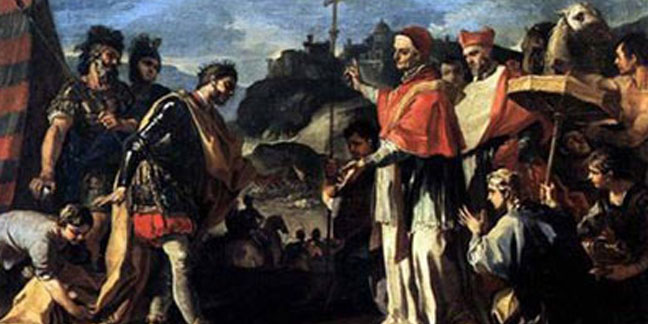The Church memorializes on Nov. 10 the fifth-century Pope St. Leo I, the first of three popes – along with Gregory (590-604) and Nicholas (858-867) – whom later generations would called "great" because of their enormous impact in the Church and in society.
His involvement in the Fourth Ecumenical Council helped prevent the spread of error about Christ's divine and human natures, he intervened for the safety of the Church in the West against barbarian invasions, and he wrote numerous sermons and letters that later prompted him to be named a Doctor of the Church.
Eastern Catholics and Eastern Orthodox Christians also maintain a devotion to the memory of St. Leo the Great. (Churches of the Byzantine tradition celebrate his feast day on Feb. 18.)
"As the nickname soon attributed to him by tradition suggests," Pope Benedict XVI said in a 2008 general audience about the saint, "he was truly one of the greatest pontiffs to have honored the Roman See and made a very important contribution to strengthening its authority and prestige."
Leo's origins are obscure and his date of birth unknown. His ancestors are said to have come from Tuscany, though the future pope may have been born in that region or in Rome itself. He became a deacon in Rome in approximately 430, during the pontificate of Pope Celestine I.
During this time, central authority was beginning to decline in the Western portion of the Roman Empire. At some point between 432 and 440, during the reign of Pope St. Celestine's successor Pope Sixtus III, the Roman Emperor Valentinian III commissioned Leo to travel to the region of Gaul and settle a dispute between military and civil officials.
Pope Sixtus III died in 440 and, like his predecessor Celestine, was canonized as a saint. Leo, away on his diplomatic mission at the time of the pope's death, was chosen to be the next Bishop of Rome. Reigning for more than two decades, he sought to preserve the unity of the Church in its profession of faith and to ensure the safety of his people against frequent barbarian invasions.
Leo used his authority, in both doctrinal and disciplinary matters, against a number of heresies troubling the Western Church – including Pelagianism (involving the denial of original sin) and Manichaeanism (a gnostic system that saw the material world as evil). In this same period, many Eastern Christians had begun arguing about the relationship between Jesus' humanity and divinity.
As early as 445, Leo had intervened in this dispute in the East, which threatened to split the churches of Alexandria and Constantinople. Its eventual resolution was, in fact, rejected in some quarters – leading to the present-day split between Eastern Orthodoxy and the so-called "non-Chalcedonian churches" which accept only three ecumenical councils.
As the fifth-century Christological controversy continued, the pope urged the gathering of an ecumenical council to resolve the matter. At the ecumenical Council of Chalcedon in 451, the pope's teaching was received as authoritative by the bishops, who proclaimed: "Peter has spoken through the mouth of Leo."
st-leo-2His teaching, known as the "Tome of Leo," brought to an end more than a century of serious Christological heresies. It confirmed that Christ's eternal divine personhood and nature did not absorb or negate the human nature that He assumed in time through the Incarnation. Instead, "the proper character of both natures was maintained and came together in a single person."
"So without leaving His Father's glory behind, the Son of God comes down from His heavenly throne and enters the depths of our world," the pope taught. "Whilst remaining pre-existent, He begins to exist in time. The Lord of the universe veiled His measureless majesty and took on a servant's form. The God who knew no suffering did not despise becoming a suffering man, and, deathless as He is, to be subject to the laws of death."
In 452, one year after the Council of Chalcedon, St. Leo led a delegation to the gates of Rome to persuade the barbarian king Attila the Hun to abandon plans to sack the city and instead withdraw beyond the Danube River. Attila had amassed an empire extending from Kazakhstan to Central Europe, and Rome was next on his list of conquered territory.
"Leave Rome to the Romans," Leo told him, "and a holy crown will come to your successors." Some claim he was referring to the future Emperor Charlemagne.
According to legend, Attila the Hun said he agreed to quickly retreat because while Leo was talking to him he saw an apparition of Sts. Peter and Paul armed with swords, threatening him with divine wrath unless he obeyed the pope.
When the Vandal leader Genseric occupied Rome three years later, the pope also confronted him, unarmed, and obtained a guarantee of safety for many of the city's inhabitants and the churches to which they had fled.
St. Leo the Great died on Nov. 10, 461. He was proclaimed a Doctor of the Church by Pope Benedict XIV in 1754.
Besides the "Tome of Leo," a collection of his 143 letters and 96 sermons still survives. His letters, written mostly to bishops, illustrate his constant efforts to bring about unity through discipline inside the Church. He also established rules for the selection of bishops and for the care of consecrated virgins. His sermons became instantly famous, especially his talks on the Incarnation of Christ.
— Catholic News Agency
More online
Learn more about the Doctors of the Church here.
Read the "Tome of Leo" and excerpts from St. Leo the Great's sermons:
www.crossroadsinitiative.com/library_author/12/st.__leo_the_great.html
www.crossroadsinitiative.com/library_article/526/Tome_of_Leo_St._Leo_the_Great.html



